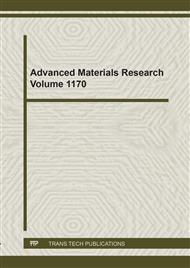[1]
S. Nakamura, M. Seno, & T. Mukai. P-GaN/N-InGaN/N-GaN double-heterostructure blue-light-emitting diodes, Japanese Journal of Applied Physics. 32 (1A) (1993) L8.
DOI: 10.1143/jjap.32.l8
Google Scholar
[2]
M. Yamada, Y. Narukawa and T. Mukai. Phosphor Free High-Luminous-Efficiency White Light-Emitting Diodes Composed of InGaN Multi-Quantum Well, Jpn. J. Appl. Phys. 41 (2002) 246– 248.
DOI: 10.1143/jjap.41.l246
Google Scholar
[3]
N. Poyiatzis, M. Athanasiou, J. Bai, Y. Gong, & T. Wang. Monolithically integrated white light LEDs on (11–22) semi-polar GaN templates, Scientific reports. 9 (1) (2019) 1-7.
DOI: 10.1038/s41598-018-37008-5
Google Scholar
[4]
Y. Li, L. Chang, H. Chen, et al. Phosphor-free InGaN white light emitting diodes using flip-chip technology, Materials. 10 (4) (2017) 432.
DOI: 10.3390/ma10040432
Google Scholar
[5]
H. Li, P. Li, H. Zhang, et al. Electrically driven, polarized, phosphor-free white semipolar (20-21) InGaN light-emitting diodes grown on semipolar bulk GaN substrate, Optics express. 28 (9) (2020) 13569-13575.
DOI: 10.1364/oe.384139
Google Scholar
[6]
J. Chang, Y. Kuo and M. Tsai. Correlation of barrier material and quantum-well number for InGaN/(In)GaN blue light-emitting diodes, physica status solidi (a). 208 (3) (2011) 729-734.
DOI: 10.1002/pssa.201026369
Google Scholar
[7]
C. Kolper, M. Sabathil, M. Mandl, M. Strassburg and B. Witzigmann. All-InGaN Phosphorless White Light Emitting Diodes: An Efficiency Estimation, Journal of Lightwave Technology. 30 (17) (2012) 2853-2862.
DOI: 10.1109/jlt.2012.2206561
Google Scholar
[8]
S. Singh, N. Rohila, S. Pal and C. Dhanavantri. Optimization towards reduction of efficiency droop in blue GaN/InGaN based light emitting diodes, Optik. 123 (14) (2012) 1287-1292.
DOI: 10.1016/j.ijleo.2011.07.061
Google Scholar
[9]
D. Kong, C. Kang, J. Lee, J. Kim and D. Lee. Color tunable monolithic InGaN/GaN LED having a multi-junction structure, Optics Express. 24 (6) (2016) A667-A673.
DOI: 10.1364/oe.24.00a667
Google Scholar
[10]
Y. Lee, P. Lin, T. Lu, H. Kuo and S. Wang. Dichromatic InGaN-based white light emitting diodes by using laser lift-off and wafer-bonding schemes, Applied Physics Letters. 90 (16) (2007) 161115.
DOI: 10.1063/1.2722672
Google Scholar
[11]
I. Ozden, E. Makarona, A. Nurmikko, T. Takeuchi and M. Krames. A dual-wavelength indium gallium nitride quantum well light emitting diode, Applied Physics Letters.79 (16) (2001) 2532-2534.
DOI: 10.1063/1.1410345
Google Scholar
[12]
H. Jian-Jang; K. Hao-Chung; S. Shyh-Chiang. Nitride Semiconductor Light-Emitting Diodes (LEDs): Materials, Technologies, and Applications. Woodhead Publishing, (2017).
DOI: 10.1016/b978-0-85709-507-7.50024-0
Google Scholar
[13]
S .Yamamoto, Y. Zhao, C. Pan, et al. High-Efficiency Single-Quantum-Well Green and Yellow-Green Light-Emitting Diodes on Semipolar (2021) GaN Substrates, Applied Physics Express. 3 (12) (2010) 122102.
DOI: 10.1143/apex.3.122102
Google Scholar
[14]
H. Sato, A. Tyagi, H. Zhong et al. High power and high efficiency green light emitting diode on free-standing semipolar (11(2)over-bar2) bulk GaN substrate, Phys Status Solidi (RRL)–Rapid Research Letters. 1 (4) (2007) 162–164.
DOI: 10.1002/pssr.200701098
Google Scholar
[15]
M. Funato, M. Ueda, Y. Kswakam et al. Blue, Green, and Amber InGaN/GaN Light-Emitting Diodes on Semipolar {11-22} GaN Bulk Substrates, Japanese Journal of Applied Physics. 45 (7L) (2006) L659.
DOI: 10.1143/jjap.45.l659
Google Scholar
[16]
A. Tyagi, H. ZHong et al. High brightness violet InGaN/GaN light emitting diodes on semipolar (1011) bulk GaN substrates, Japanese Journal of Applied Physics. 46 (2L) (2007) L129.
DOI: 10.1143/jjap.46.l129
Google Scholar
[17]
I. Park, J. Kim, M. Kwon, C. Cho, J. Lim and S. Park. Phosphor-free white light-emitting diode with laterally distributed multiple quantum wells, Applied Physics Letters. 92(9) (2008) 091110.
DOI: 10.1063/1.2890492
Google Scholar
[18]
LI, Simon; LI, Suihua. 3D TCAD Simulation for Semiconductor Processes, Devices and Optoelectronics. Springer Science & Business Media, (2011).
Google Scholar
[19]
ATLAS Manual. 2013, Silvaco Software Inc.
Google Scholar
[20]
F. Bernardini, V. Fiorentini, and D.Vanderbilt. Spontaneous polarization and piezoelectric constants of III-V nitrides, Physical Review B. 56 (16) (1997) R10024.
DOI: 10.1103/physrevb.56.r10024
Google Scholar
[21]
J. Piprek, Semiconductor Optoelectronic Devices: Introduction to Physics and Simulation, UCSB: Academic Press (2003): 22.
Google Scholar
[22]
E.F. Schubert, T. Gessmann, et J. K. Kim. Inorganic semiconductors for light-emitting diodes. Organic Light Emitting Devices, (2006) 1-33.
DOI: 10.1002/3527607986.ch1
Google Scholar
[23]
V.Avrutin, F. Zhang, S.A. Hafiz, H. Morkoc, et al. Saga of efficiency degradation at high injection in InGaN light emitting diodes, Turkish J. Phys. 38 (3) (2014) 269-313.
DOI: 10.3906/fiz-1407-23
Google Scholar
[24]
J. Schanda, ed. Colorimetry: understanding the CIE system, John Wiley & Sons. (2007).
Google Scholar
[25]
R. J. Mortimer, & T. S. Varley. Quantification of colour stimuli through the calculation of CIE chromaticity coordinates and luminance data for application to in situ colorimetry studies of electrochromic materials, Displays. 32 (1) (2011) 35-44.
DOI: 10.1016/j.displa.2010.10.001
Google Scholar
[26]
E.F. Schubert. Light-Emitting Diodes, 2nd ed. New York: Cambridge University Press, (2006).
Google Scholar
[27]
Information on https://www.ies.org/definitions/table-t-5a-color-matching-functions-and-chromaticity-coordinates-of-cie-1931-standard-colorimetric-observer/.
Google Scholar
[28]
Y. Sayad and A.K. Nouiri. Electroluminescence properties of InGaN/GaN multiple quantum well light emitting diodes, International Journal of Nanoparticles 11. 6 (2-3) (2013) 201-207.
DOI: 10.1504/ijnp.2013.054995
Google Scholar
[29]
J. Piprek. Efficiency droop in nitride-based light-emitting diodes, Phys. Status Solidi (a). 207 (10) (2010) 2217–2225.
DOI: 10.1002/pssa.201026149
Google Scholar
[30]
Y. C. Shen, G.O. Mueller, S. Watanabe, et al. Auger recombination in InGaN measured by photoluminescence, Applied Physics Letters. 91 (14) (2007) 141101-141103.
DOI: 10.1063/1.2785135
Google Scholar
[31]
G. Muziol, H. Turski, M. Siekacz, et al. Beyond quantum efficiency limitations originating from the piezoelectric polarization in light-emitting devices, ACS Photonics. 6 (8) (2019) 1963-1971.
DOI: 10.1021/acsphotonics.9b00327
Google Scholar
[32]
S. Zhang, J. Zhang, J. Gao, et al. Efficient emission of InGaN-based light-emitting diodes: toward orange and red, Photonics Research. 8 (11) (2020) 1671-1675.
DOI: 10.1364/prj.402555
Google Scholar


